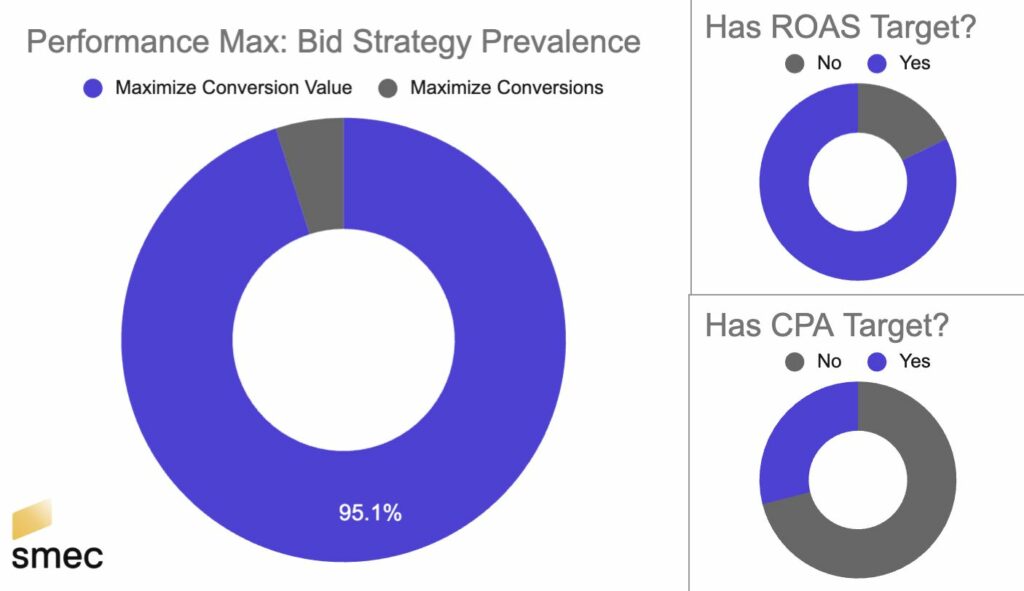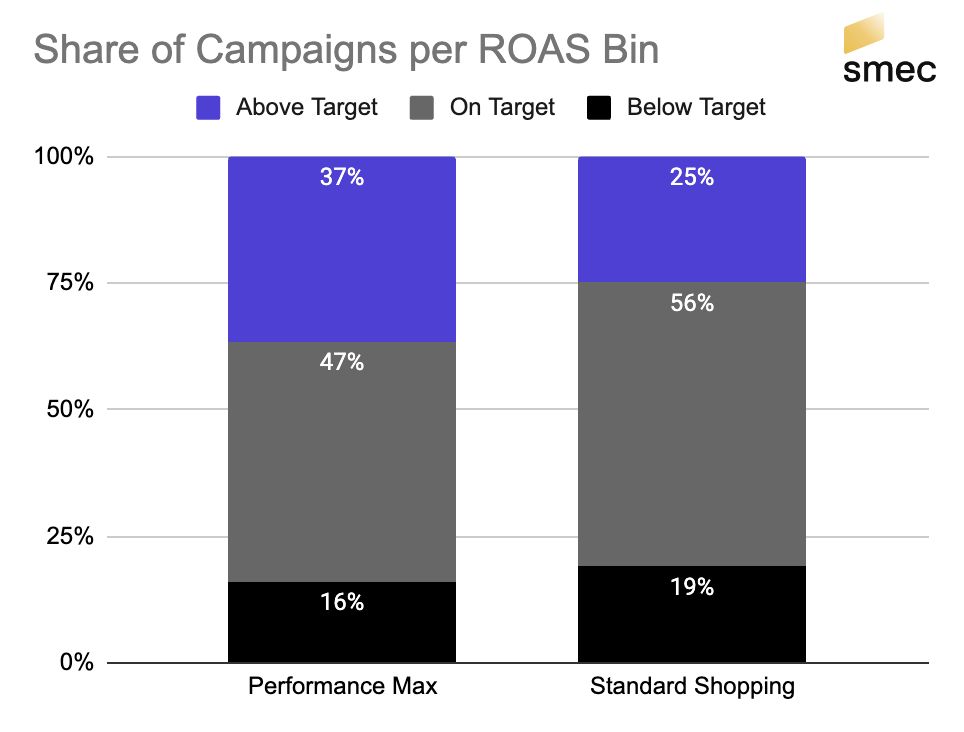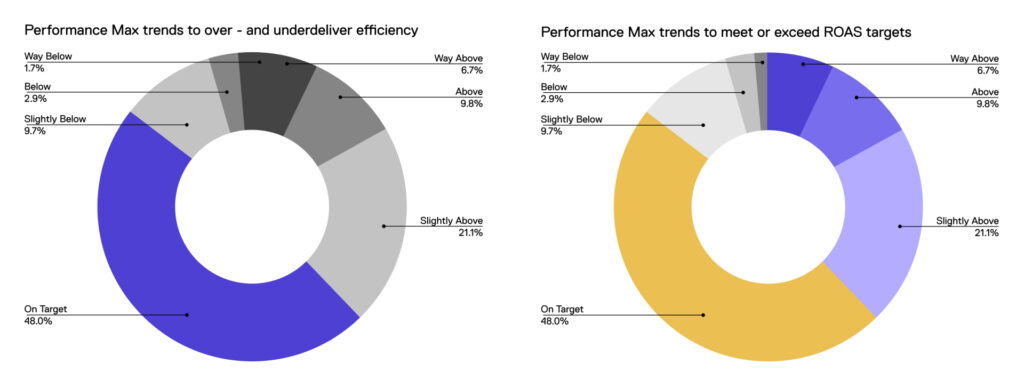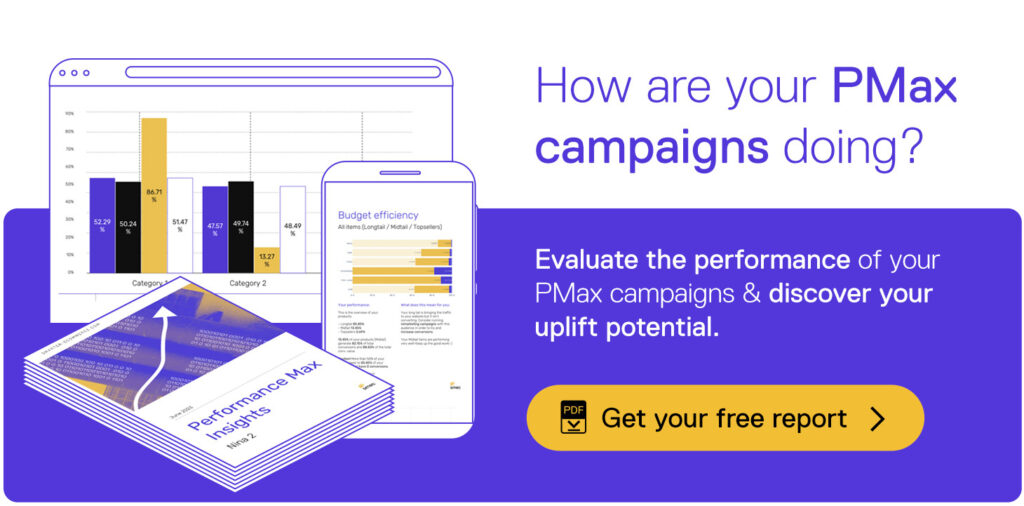Subscribe to join thousands of other ecommerce experts

In the world of ecommerce advertising, leveraging the right bidding strategy can make all the difference in campaign success. Performance Max (PMax) campaigns have become a popular choice for ecommerce advertisers due to their data-driven approach and ability to optimize bids across multiple platforms. In this blog post, we will embark on an insightful journey, guided by Mike Ryan’s deep dive into 3,000 PMax campaigns, to explore the efficacy of different bidding strategies. We will explore the overwhelming popularity of Target ROAS (tROAS) and uncover the impact it has on PMax campaign performance.
Update 2024: At Smarter Ecommerce (smec), we’ve gathered insights from over 12 months of campaign data to understand the impact of target ROAS changes on actual campaign performance. Dive deep into our extensive research if you’d like to learn more of the effects we’ve observed.
Table of Contents
Retail Campaigns Data Unveiled: Dominance of Target ROAS
Mike’s audit offers valuable insights into the preferences of ecommerce advertisers when it comes to bidding objectives. Not surprisingly, the majority of campaigns (90%) are focused on maximizing conversion value, primarily revenue. Within this segment, 8 out of 10 campaigns adopt an efficiency target, commonly known as tROAS, to optimize their advertising spend effectively.
Interestingly, there is a small minority of campaigns (5%) that opt for Max Conversions bidding. A noteworthy observation is that most of these campaigns do not set a cost-per-acquisition efficiency target (tCPA). They often aim to capture non-purchase conversions, such as newsletter signups.
tROAS and tCPA, which used to be standalone bid strategies, are now considered subsets of the parent strategies Max Conversion Value and Max Conversions, respectively. If we break them out and analyze the total share of campaigns per bid strategy, we find that tROAS stands as the overwhelming winner of this popularity contest:
- Target ROAS: 78.2%
- Max Conv. Value: 16.9%
- Max Conversions: 3.5%
- Target CPA: 1.4%

Data: smec
Let’s now dig deeper into whether tROAS effectively delivers on its promises.
The Power of Target ROAS: Unpacking the Numbers
Now that we know tROAS is the preferred bidding strategy, the big question arises – does it actually work? Mike’s analysis uncovers the truth – tROAS is a successful bidding strategy for both Performance Max and Standard Shopping campaigns.
In the PMax ecosystem, Target ROAS meets or even exceeds targets in an impressive 84% of campaigns. Standard Shopping campaigns show a similar percentage, but there are more campaigns that successfully hit the “on target” mark, defined as achieving ROAS within ±10% of the set goal.

Source: smec
However, the effectiveness of tROAS sparks an intriguing philosophical discussion. Is Performance Max superior in consistently overachieving the ROAS target? Or is Standard Shopping superior in adhering more closely to the target?
The answer to this age-old question largely hinges on one critical factor – revenue volume. tROAS is fundamentally a subset of the Max Conversion Value strategy, emphasizing the growth of revenue above all else.
Another important consideration arises – does tROAS genuinely generate incremental revenue in campaigns? Or does it simply tap into warm traffic that was already likely to convert, irrespective of the bidding strategy?
Deciphering the Impact: Optimizing tROAS for Performance Max
Our exploration into the efficacy of tROAS presents intriguing insights, but it also raises critical questions. So let’s dig deeper.
A visual representation in the form of a donut chart allows us to view the same data through two different lenses: the optimistic case and the pessimistic case.
In the optimistic case (right), we consider on-target performance as neutral, represented in gold. We code below-target performance in grey and above-target ROAS in blue, as higher ROAS indicates better results.
Conversely, the pessimistic case (left) depicts on-target performance in blue, acknowledging that this is a target ROAS bid strategy. Any deviation from the target, whether above or below, is represented in grey. This color mapping highlights the potential mismatch between efficiency and volume. For instance, if PMax overachieves ROAS targets a third of the time, it may underachieve revenue volume, calling into question the true incremental value.

Source of data: smec
Conclusion
In conclusion, Mike Ryan‘s audit of 3,000 Performance Max (PMax) campaigns unveiled Target ROAS (tROAS) as the favored and highly successful bidding method in the world of ecommerce advertising. A staggering 78.2% of campaigns have adopted tROAS, proving its effectiveness in both Performance Max and conventional Shopping campaigns, with a success rate of 84% in meeting or surpassing goals.
However, despite its success, thought-provoking questions emerge. Such as, whether advertisers should focus on consistently overachieving efficiency targets? Or should they stick closely to predetermined goals? The answer lies in understanding tROAS’s primary focus on driving revenue growth, making it a critical subset of the Max Conversion Value strategy.
Yet, the critical question remains – is the revenue generated indeed incremental or simply a result of the strategy’s ability to convert warm traffic? To unveil the answer, further exploration into proxy metrics becomes essential.
Understanding the nuances of tROAS is crucial in this dynamic and constantly changing world of ecommerce advertising. Armed with this data-driven analysis, advertisers can make informed decisions, fine-tune their bidding strategies, and and tap into hidden possibilities for unmatched success.
So, seize this opportunity to optimize your advertising endeavors. Implement tROAS in your campaigns, embrace data-driven insights, and explore proxy metrics to gain a comprehensive understanding of your campaign’s impact. By doing so, you can harness the full potential of Performance Max bidding strategies and drive remarkable results!

And always feel free to contact us in case you have any questions in regard to tROAS or your Performance Max campaigns – we are more than happy to talk!
FAQ
To unlock the full potential of Target ROAS (tROAS) within Performance Max campaigns, conversion volume plays a pivotal role. Analysis of over 14,000 campaigns at Smarter Ecommerce revealed that PMax’s efficiency scales with data volume:
– Under 30 conversions/month? Expect inconsistent results and a high risk of underperforming against tROAS targets.
– 60-90 conversions? Stability improves, but hitting ROAS targets remains a 50/50 shot.
– 150+ conversions? Campaigns reliably meet or exceed ROAS goals, showcasing the value of a robust data set.
These findings emphasize that PMax thrives on data to identify patterns and optimize effectively. However, reaching sufficient conversion thresholds often requires strategic planning around budgets and product segmentation. A smarter approach, like smec’s multi-dimensional product segmentation, ensures even lesser-known products contribute to achieving your tROAS goals by analyzing broader business potential instead of relying solely on past performance.
If you’d like to see the data behind this analysis, head over to our deep dive on the topic for a closer look.
Adjusting Target ROAS isn’t just a simple setting change—it sets off a chain of reactions in your campaigns. Start with small adjustments, stay patient, and closely monitor your data to navigate the algorithm’s unpredictability. We have analyzed 12 months of campaign data to understand the impact of such changes and compiled a guide here.

